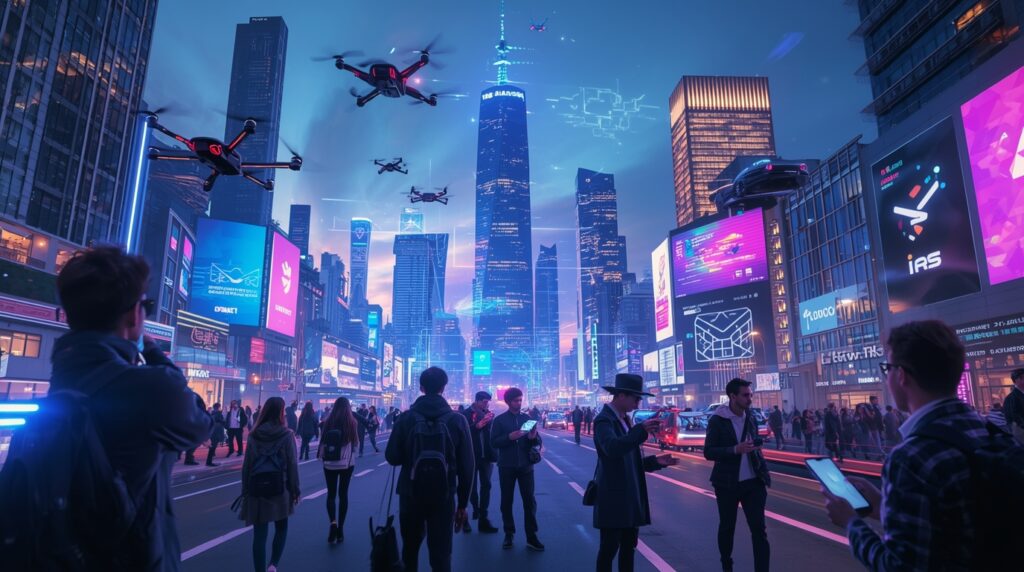Introduction A World After Smartphones
In today’s fast-evolving tech landscape, tech giants envision future beyond smartphones as the next logical leap in digital innovation. The handheld device that once revolutionized human communication is reaching its limits. Now, a new generation of devices more immersive, intelligent, and seamlessly integrated into our lives is emerging to take its place.
Why Tech Giants Envision Future Beyond Smartphones
The Saturation of the Smartphone Market
Smartphone sales have plateaued globally. Markets are oversaturated, innovation has slowed, and users no longer see dramatic upgrades. Giants like Apple, Google, and Samsung are seeking the next computing interface that can drive growth, just as smartphones did after the PC era.
The Technological Breakthroughs Driving the Change
Advancements in AI, 5G, miniaturization, and augmented reality (AR) are unlocking new possibilities. Devices are becoming smaller, smarter, and more intuitive. With the rise of spatial computing and ambient intelligence, we are moving from “handheld” to “hands-free” technology.
The Next Digital Devices Set to Replace Smartphones
Smart Glasses and Augmented Reality
Smart glasses are at the forefront of this revolution. They allow users to overlay digital information onto the physical world directions, messages, live translation, and real-time data directly into your field of view. Apple’s rumored AR glasses and Meta’s collaboration with Ray-Ban demonstrate how close we are to practical adoption.
Mixed Reality Headsets and Spatial Computing
Mixed Reality (MR) blends the real and digital environments seamlessly. The Apple Vision Pro, for instance, is redefining personal computing through immersive experiences that merge productivity, entertainment, and creativity.
Wearable Devices and Smart Patches
Next-gen wearables go far beyond smartwatches. Skin-based sensors, smart patches, and clothing-integrated electronics will continuously track health data and environmental conditions, giving real-time insights to users and healthcare providers.
Brain-Computer Interfaces (BCI)
Companies like Neuralink are exploring brain-computer interfaces that enable direct communication between the brain and machines. Though still in early stages, BCIs could replace touchscreens and voice commands entirely making technology an extension of human thought.
Ambient Computing and the Invisible Device Revolution
Ambient computing represents the true next digital frontier where devices fade into the background and technology anticipates our needs automatically. Smart homes powered by Amazon Alexa and Google Nest are early examples of this paradigm.
Major Players Shaping the Post-Smartphone Era
Apple’s Vision Pro and Beyond
Apple’s Vision Pro marks the start of spatial computing. By integrating AR, advanced sensors, and AI-driven interfaces, Apple is preparing a seamless shift from iPhone to wearable ecosystems.
Google and the AR Glass Ecosystem
After its early experiment with Google Glass, the company is now building an AR operating system that merges AI with its cloud infrastructure turning daily experiences into intelligent digital overlays.
Meta’s Metaverse and Wearable Future
Meta is betting on the Metaverse, where digital and physical worlds coexist. Through Quest headsets and AR glasses, Meta aims to create always-on social and professional environments.
Microsoft’s HoloLens and Enterprise Integration
Microsoft HoloLens leads enterprise applications healthcare, engineering, and training. Its combination of AI, mixed reality, and cloud computing makes it vital for industrial transformation.
Amazon and the Ambient Smart Home
Amazon is pushing ambient AI through Alexa, Echo, and its growing network of IoT devices. Its vision: a world where every home becomes an intelligent ecosystem.
(Read more about ambient computing on Amazon Science.)
Key Challenges Facing the Post-Smartphone Revolution
Power, Battery, and Miniaturization
To make wearables mainstream, devices must balance performance, heat, and battery life. Solid-state batteries and energy-efficient chips are critical innovations under development.
Privacy, Data Security, and Ethics
As devices become more intimate tracking health, location, and even neural data privacy and ethical AI become top concerns. Regulatory frameworks must evolve to protect consumers.
Social Acceptance and Cultural Shifts
From Google Glass backlash to privacy worries, society must adapt to visible and invisible technologies. Comfort, design, and trust will shape adoption.
Developer Ecosystem and Interoperability
Without rich applications, even the most advanced device will fail. Developers need open APIs, SDKs, and cross-platform tools to create compelling AR, VR, and BCI experiences.
(For standards updates, see W3C Immersive Web Working Group.)
The Road Ahead: Predictions for 2025–2035
The Transition Years (2025–2030)
Early adopters embrace AR glasses and mixed-reality headsets. Smartphones remain secondary but start to fade in everyday tasks.
Mainstream Adoption (2030–2035)
Lightweight AR wearables, embedded computing, and ambient AI become affordable. Most daily interactions navigation, messaging, shopping occur through head-mounted or environment-based interfaces.
The Fully Connected Ambient Future (Beyond 2035)
Technology disappears into the background. Brain-computer interfaces, smart fabrics, and digital ecosystems form a continuous web of connectivity that enhances life without distraction.
FAQs: Future Beyond Smartphones
Q1: What does it mean when tech giants envision future beyond smartphones?
It means companies are developing new platforms AR glasses, wearables, and BCIs that will replace smartphones as the main human-computer interface.
Q2: Which company leads this post-smartphone shift?
Apple, Google, Meta, and Microsoft each lead in different segments Apple in AR, Meta in XR, Microsoft in enterprise MR, and Google in AI + cloud ecosystems.
Q3: When will smartphones truly disappear?
Experts predict smartphones will decline sharply between 2030 and 2035, as AR and wearable interfaces become dominant.
Q4: What are the biggest barriers to adoption?
Battery limitations, cost, privacy issues, and cultural resistance remain major challenges.
Q5: How should developers prepare for this new era?
Developers should learn AR/VR tools like Unity, Unreal Engine, and WebXR, and focus on spatial computing interfaces.
Conclusion Entering the Next Digital Frontier
As tech giants envision future beyond smartphones, they are shaping a reality where technology blends seamlessly with human life. From smart glasses to brain-computer interfaces, these innovations mark the next evolution in computing one that promises to make digital experiences more intuitive and immersive than ever before.

